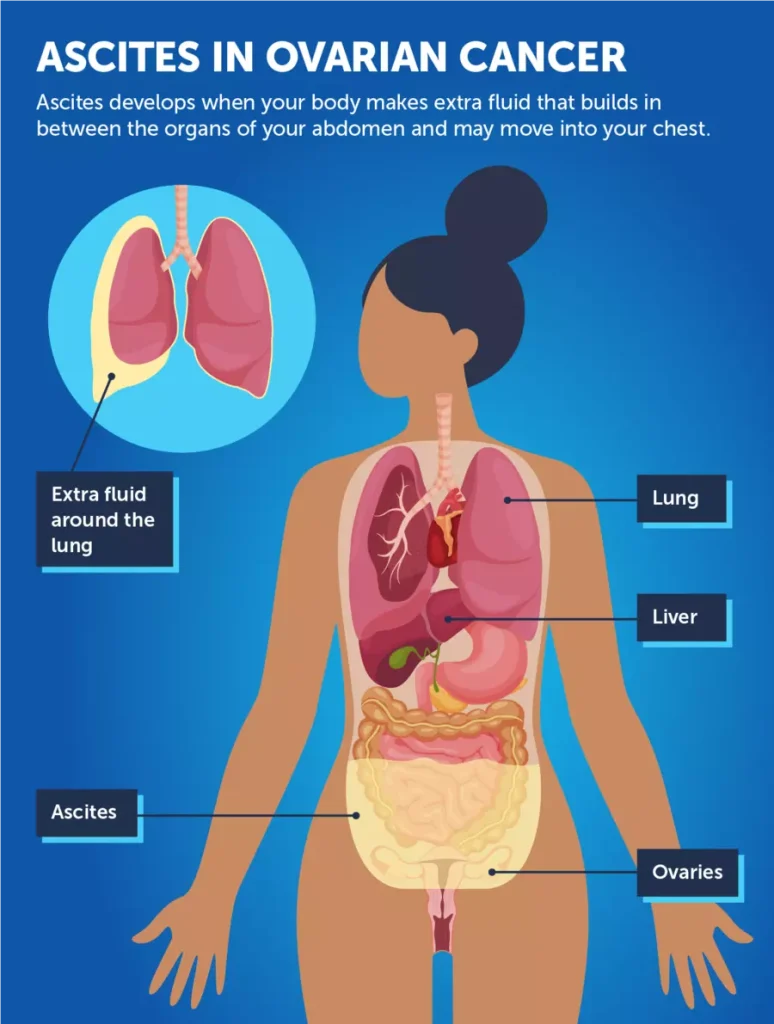
Cancer cells can inflame the lung lining (pleura) or abdominal lining (peritoneum). This can cause fluid to build up. The fluid might contain cancer cells.
Fluid around the lungs is called a pleural effusion. It can make it difficult to breathe. Draining fluid from your chest is called thoracocentesis or pleural aspiration.
Fluid in the tummy (abdomen) is called peritoneal ascites. It can make the abdomen feel swollen, tight and uncomfortable. Draining fluid from your abdomen is called an abdoparacentesis or peritoneal aspiration.
Why you might have it
The doctors might drain fluid from around your lungs or abdomen to:
- see if the fluid contains cancer cells
- help control symptoms
Preparing for the drainage
The doctor can often drain the fluid on the ward or as a day patient. You might need to stay in hospital overnight. You have a local anaesthetic which means you are awake.
To drain fluid around your lungs, you sit on a chair or on the edge of the bed. You lean forward over a table with a pillow on it.
To drain fluid in your abdomen, you can lie down on a bed or a reclining chair.
Draining fluid during surgery
Sometimes, the doctor might drain fluid during a small operation called a thoracotomy or a laparotomy. You have these operations in an endoscopy suite or operating theatre. You can read about preparing for a laparotomy and thoracotomy in the general test section.

What happens?
The doctor cleans your skin with antiseptic. They numb the area with an injection of local anaesthetic.
To drain the fluid off, your doctor uses a needle (cannular) to put a small tube into the chest or abdomen. They attach this to a tube with a bag at the end of it. The fluid drains through the tube into the bag.
After the test
The doctor might make a couple of stitches in the skin to hold the catheter in place. You have a dressing over the tube which also helps to keep it in position.
You might only need to have the tube in for a few hours. But there is a lot of fluid, you might have the drain in for a few days. Some people might have a permanent drain that can stay in for a few months.
The doctor sends a sample of the fluid to a laboratory for testing. This is to see if it contains cancer cells.
Possible problems
Low blood pressure
Your blood pressure may drop and make you feel ill if the fluid drains too quickly. Your nurses will check your blood pressure and pulse regularly.
Pain and discomfort
Your nurse can give you painkillers if you need them. They can also help you change your position to make you comfortable.
Blockage
The tube can block. This stops the fluid from draining. Your doctor or nurse might ask you to change position or sit upright to see if this helps the tube to drain again. If this doesn’t work, the doctor might need to remove the tube and put in a new one.
A collapsed lung (pneumothorax)
After the fluid drains from around your lung, air can collect in the space. This can make the lung collapse. This is called a pneumothorax. Contact a doctor if you become short of breath or have chest pain. You might not need any treatment and it goes on its own. Sometimes, your doctor might need to put another tube into the lung to remove the air.
Infection
There is a small risk of infection. Your nurse will check the site where the tube is for any signs of infection. They will also monitor your temperature. You can have antibiotics if you develop an infection.
Bleeding
There is a small risk of bleeding when the doctors put in the tube. This usually stops without any treatment.
Getting your results
You should get your results within 1 or 2 weeks. The doctor may be able to tell you if they have seen any cancer cells in the fluid sample that was sent to the laboratory.
Waiting for results can make you anxious. Ask your doctor or nurse how long it will take to get them.
Contact the doctor who arranged the test if you haven’t heard anything after a couple of weeks.
You might have contact details for a specialist nurse and you can contact them for information if you need to. It can help to talk to a close friend or relative about how you feel.





